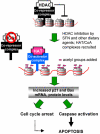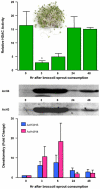Dietary histone deacetylase inhibitors: from cells to mice to man
- PMID: 17555985
- PMCID: PMC2737738
- DOI: 10.1016/j.semcancer.2007.04.001
Dietary histone deacetylase inhibitors: from cells to mice to man
Abstract
Sulforaphane (SFN) is an isothiocyanate found in cruciferous vegetables, such as broccoli and broccoli sprouts. This anticarcinogen was first identified as a potent inducer of Phase 2 detoxification enzymes, but evidence is mounting that SFN also acts through epigenetic mechanisms. SFN has been shown to inhibit histone deacetylase (HDAC) activity in human colon and prostate cancer lines, with an increase in global and local histone acetylation status, such as on the promoter regions of P21 and bax genes. SFN also inhibited the growth of prostate cancer xenografts and spontaneous intestinal polyps in mouse models, with evidence for altered histone acetylation and HDAC activities in vivo. In human subjects, a single ingestion of 68 g broccoli sprouts inhibited HDAC activity in circulating peripheral blood mononuclear cells 3-6 h after consumption, with concomitant induction of histone H3 and H4 acetylation. These findings provide evidence that one mechanism of cancer chemoprevention by SFN is via epigenetic changes associated with inhibition of HDAC activity. Other dietary agents such as butyrate, biotin, lipoic acid, garlic organosulfur compounds, and metabolites of vitamin E have structural features compatible with HDAC inhibition. The ability of dietary compounds to de-repress epigenetically silenced genes in cancer cells, and to activate these genes in normal cells, has important implications for cancer prevention and therapy. In a broader context, there is growing interest in dietary HDAC inhibitors and their impact on epigenetic mechanisms affecting other chronic conditions, such as cardiovascular disease, neurodegeneration and aging.
Figures





Similar articles
-
Modulation of histone deacetylase activity by dietary isothiocyanates and allyl sulfides: studies with sulforaphane and garlic organosulfur compounds.Environ Mol Mutagen. 2009 Apr;50(3):213-21. doi: 10.1002/em.20454. Environ Mol Mutagen. 2009. PMID: 19197985 Free PMC article. Review.
-
Sulforaphane retards the growth of human PC-3 xenografts and inhibits HDAC activity in human subjects.Exp Biol Med (Maywood). 2007 Feb;232(2):227-34. Exp Biol Med (Maywood). 2007. PMID: 17259330 Free PMC article.
-
A novel mechanism of chemoprotection by sulforaphane: inhibition of histone deacetylase.Cancer Res. 2004 Aug 15;64(16):5767-74. doi: 10.1158/0008-5472.CAN-04-1326. Cancer Res. 2004. PMID: 15313918
-
Sulforaphane inhibits histone deacetylase in vivo and suppresses tumorigenesis in Apc-minus mice.FASEB J. 2006 Mar;20(3):506-8. doi: 10.1096/fj.05-4785fje. Epub 2006 Jan 11. FASEB J. 2006. PMID: 16407454 Free PMC article.
-
Multi-targeted prevention of cancer by sulforaphane.Cancer Lett. 2008 Oct 8;269(2):291-304. doi: 10.1016/j.canlet.2008.04.018. Epub 2008 May 27. Cancer Lett. 2008. PMID: 18504070 Free PMC article. Review.
Cited by
-
Proteostasis strategies for restoring alpha1-antitrypsin deficiency.Proc Am Thorac Soc. 2010 Nov;7(6):415-22. doi: 10.1513/pats.201001-016AW. Proc Am Thorac Soc. 2010. PMID: 21030523 Free PMC article. Review.
-
Disruption of Epithelial HDAC3 in Intestine Prevents Diet-Induced Obesity in Mice.Gastroenterology. 2018 Aug;155(2):501-513. doi: 10.1053/j.gastro.2018.04.017. Epub 2018 Apr 22. Gastroenterology. 2018. PMID: 29689264 Free PMC article.
-
Anticancer Activity of Sulforaphane: The Epigenetic Mechanisms and the Nrf2 Signaling Pathway.Oxid Med Cell Longev. 2018 Jun 6;2018:5438179. doi: 10.1155/2018/5438179. eCollection 2018. Oxid Med Cell Longev. 2018. PMID: 29977456 Free PMC article. Review.
-
Dietary Sulforaphane in Cancer Chemoprevention: The Role of Epigenetic Regulation and HDAC Inhibition.Antioxid Redox Signal. 2015 Jun 1;22(16):1382-424. doi: 10.1089/ars.2014.6097. Epub 2014 Dec 19. Antioxid Redox Signal. 2015. PMID: 25364882 Free PMC article. Review.
-
Augmentation of Cationic Antimicrobial Peptide Production with Histone Deacetylase Inhibitors as a Novel Epigenetic Therapy for Bacterial Infections.Antibiotics (Basel). 2015 Jan 12;4(1):44-61. doi: 10.3390/antibiotics4010044. Antibiotics (Basel). 2015. PMID: 27025614 Free PMC article. Review.
References
-
- Shames DS, Minna JD, Gazdar AF. DNA methylation in health, disease, and cancer. Curr Mol Med. 2007;7:85–102. - PubMed
-
- Fraga MF, Ballestar, Villar-Garea A, Boix-Chornet M, Espada J, Schotta G, et al. Loss of acetylation at Lys 16 and trimethylation at Lys 20 of histone H4 is a common hallmark of human cancer. Nat Genet. 2005;37:391–400. - PubMed
-
- Marks PA. Discovery and development of SAHA as an anticancer agent. Oncogene. 2007;26:1351–6. - PubMed
Publication types
MeSH terms
Substances
Grants and funding
- P01 CA090890/CA/NCI NIH HHS/United States
- CA90890/CA/NCI NIH HHS/United States
- R01 CA122906/CA/NCI NIH HHS/United States
- CA80176/CA/NCI NIH HHS/United States
- R01 CA065525/CA/NCI NIH HHS/United States
- R01 CA107693/CA/NCI NIH HHS/United States
- CA122906/CA/NCI NIH HHS/United States
- CA65525/CA/NCI NIH HHS/United States
- P30 ES000210/ES/NIEHS NIH HHS/United States
- P30 ES00210/ES/NIEHS NIH HHS/United States
- R01 CA080176/CA/NCI NIH HHS/United States
- CA107693/CA/NCI NIH HHS/United States
- R29 CA065525/CA/NCI NIH HHS/United States
LinkOut - more resources
Full Text Sources
Other Literature Sources
Research Materials
Miscellaneous

